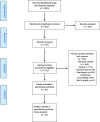Accuracy of diagnostic tests in cardiac injury after blunt chest trauma: a systematic review and meta-analysis
- PMID: 37245048
- PMCID: PMC10225099
- DOI: 10.1186/s13017-023-00504-9
Accuracy of diagnostic tests in cardiac injury after blunt chest trauma: a systematic review and meta-analysis
Abstract
Introduction: The diagnosis of cardiac contusion, caused by blunt chest trauma, remains a challenge due to the non-specific symptoms it causes and the lack of ideal tests to diagnose myocardial damage. A cardiac contusion can be life-threatening if not diagnosed and treated promptly. Several diagnostic tests have been used to evaluate the risk of cardiac complications, but the challenge of identifying patients with contusions nevertheless remains.
Aim of the study: To evaluate the accuracy of diagnostic tests for detecting blunt cardiac injury (BCI) and its complications, in patients with severe chest injuries, who are assessed in an emergency department or by any front-line emergency physician.
Methods: A targeted search strategy was performed using Ovid MEDLINE and Embase databases from 1993 up to October 2022. Data on at least one of the following diagnostic tests: electrocardiogram (ECG), serum creatinine phosphokinase-MB level (CPK-MB), echocardiography (Echo), Cardiac troponin I (cTnI) or Cardiac troponin T (cTnT). Diagnostic tests for cardiac contusion were evaluated for their accuracy in meta-analysis. Heterogeneity was assessed using the I2 and the QUADAS-2 tool was used to assess bias of the studies.
Results: This systematic review yielded 51 studies (n = 5,359). The weighted mean incidence of myocardial injuries after sustaining a blunt force trauma stood at 18.3% of cases. Overall weighted mean mortality among patients with blunt cardiac injury was 7.6% (1.4-36.4%). Initial ECG, cTnI, cTnT and transthoracic echocardiography TTE all showed high specificity (> 80%), but lower sensitivity (< 70%). TEE had a specificity of 72.1% (range 35.8-98.2%) and sensitivity of 86.7% (range 40-99.2%) in diagnosing cardiac contusion. CK-MB had the lowest diagnostic odds ratio of 3.598 (95% CI: 1.832-7.068). Normal ECG accompanied by normal cTnI showed a high sensitivity of 85% in ruling out cardiac injuries.
Conclusion: Emergency physicians face great challenges in diagnosing cardiac injuries in patients following blunt trauma. In the majority of cases, joint use of ECG and cTnI was a pragmatic and cost-effective approach to rule out cardiac injuries. In addition, TEE may be highly accurate in identifying cardiac injuries in suspected cases.
Keywords: Blunt chest trauma; Cardiac concussion; Cardiac contusion; Commotio cordis; Contusio cordis; Diagnostic protocol.
© 2023. The Author(s).
Conflict of interest statement
The authors declare no competing interests.
Figures
References
Publication types
MeSH terms
Substances
LinkOut - more resources
Full Text Sources
Medical
Research Materials
Miscellaneous



